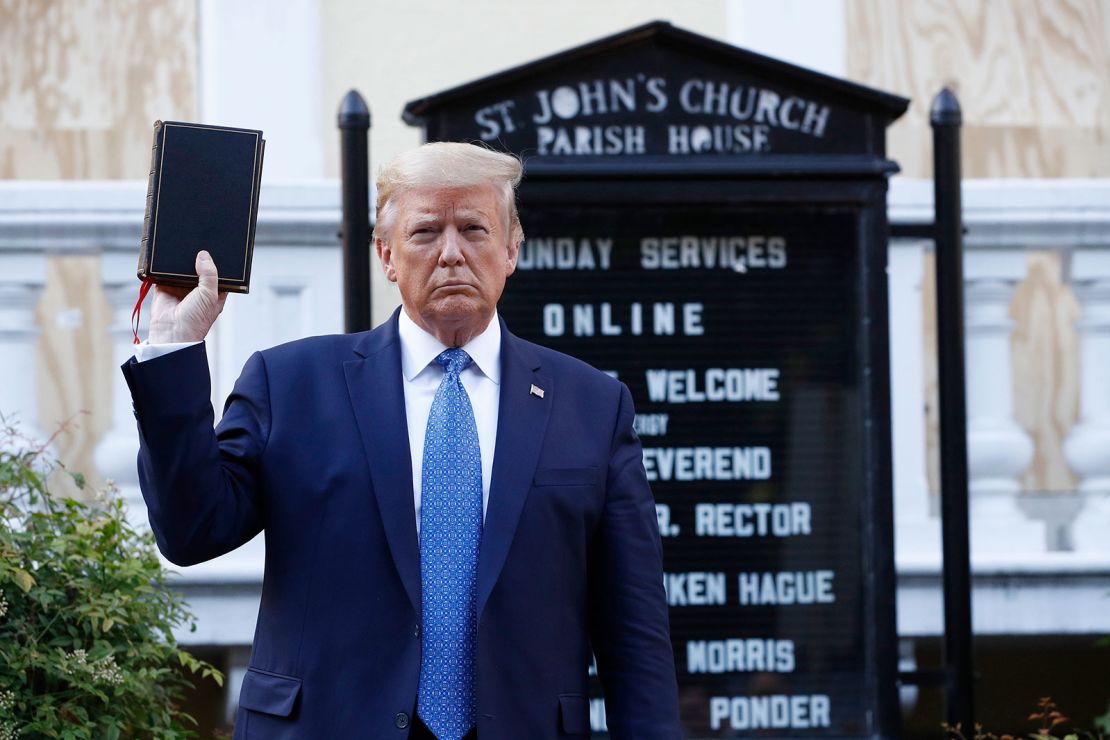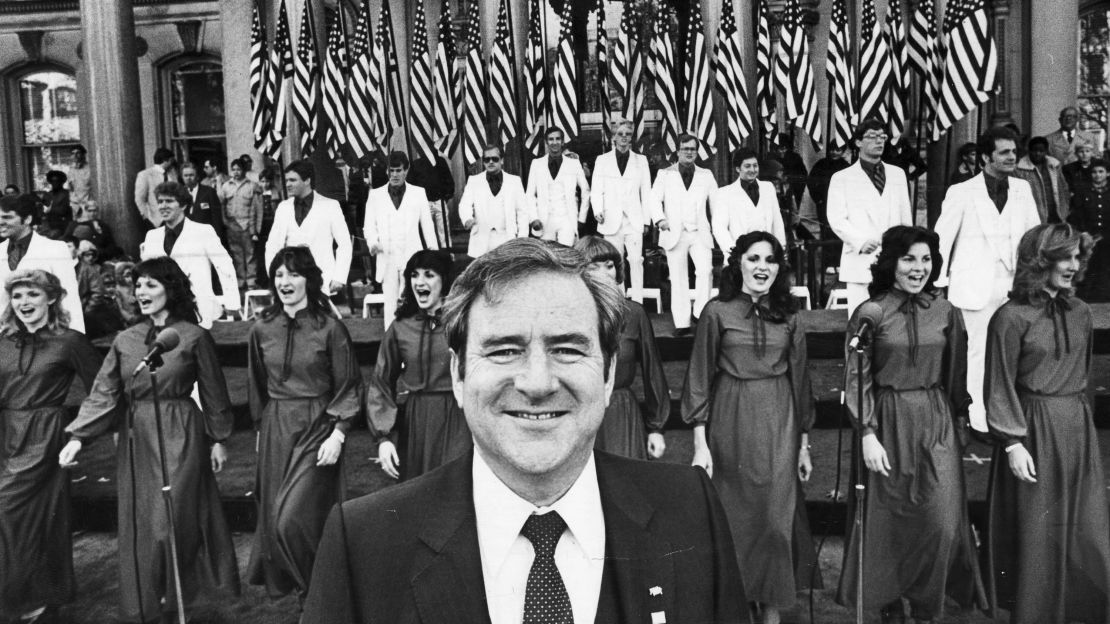Editor’s Note: Diana Butler Bass (@DianaButlerBass) is the author of 10 books on American religion and cultural trends, including her most recent, “Grateful: The Transformative Power of Giving Thanks (2018).” She is currently writing a book about images of Jesus. The views expressed here are hers. Read more opinion on CNN.
The photograph of President Donald Trump at the steps of St. John’s Episcopal Church, holding a Bible high, has become an icon of this American moment.

As an Episcopalian, I was mortified by the use of one of my denomination’s churches as a backdrop for President Trump’s call for a military crackdown. As a Christian, I was shocked when he brandished a book of love to sanction violence against American citizens. As a person of faith, I was offended as he made God as a prop, seeking to further divide the nation into tribes of righteous followers versus heathen protesters. And, as a human being I was appalled to watch Trump – with his history of bigotry and racism – cloak himself in a mantle of faith.
I am not alone in this indignation.
Episcopal bishops and clergy, Christian ministers from many denominations, religious leaders from other faiths, and many people of goodwill have disavowed both Trump’s actions and the photograph. Not that it mattered very much. On the morning following the photo at St. John’s, Trump reenacted the stunt at a Roman Catholic shrine. There, he and the first lady posed in front the statue of John Paul II as if they were receiving a blessing from the hand of the sainted pope. From church and Bible to mitre and crucifix, Trump made his point of divine approval an ecumenical affair.
The picture was taken after President Trump announced a new regime of “law and order” to crush the protests following the death in police custody of George Floyd, a black man from Minneapolis. In Washington, protesters gathered outside the White House, near the church. Over the weekend, protests had turned violent at night, including the church – located across the street from the White House, with a long history of significance to presidents and others with political power – being set on fire (the blaze was quickly controlled).
During Monday’s “law and order” speech, as Trump boasted about increased military presence, police forces used tear gas, flash grenades and rubber bullets against peaceful protesters (including clergy) who had regathered at St. John’s.
Once the streets were cleared, Trump strode triumphantly from the White House to the church. When he arrived, he lifted the Bible up – almost if proclaiming his cause sacred. He then posed with senior officials, including the secretary of defense, who, understanding how problematic this was, has sought to distance himself from it – saying Wednesday that he does not “support invoking the Insurrection Act,” calling the killing of George Floyd a “horrible crime” and describing racism as “real in America…we must all do our very best to recognize it, to confront it, and to eradicate it.”
In many ways, there is nothing particularly new about such politicized images involving religion. American history is rife with politicians claiming authority from the Bible for their own agendas. Some of those agendas – like abolition during the 19th century or peace movements during the 20th – have seemed in line with sacred teaching; while other agendas – like racism and militaristic nationalism – run counter to biblical mandates for compassion and neighborly love.
Much has already been said in the media and elsewhere about the appropriation of two of Washington’s great Christian landmarks, especially about the misuse of religion for political purposes and outrage about the desecration of sacred places (when in recent memory has the word “desecration” been so widely used in the press?).
And much more needs to be said about these incidents regarding the dismal complicity of America’s majority-white Christian denominations with racism and systemic injustice – as well as the tendency of Washington’s religious establishment to embrace the presidency and political power, even when it is at cross-purposes with the God they proclaim. There have already been many words of shock, grief and anger; there will be many more of analysis – historical, racial and political – yet to come.

In the meanwhile, we are left not with words, but with an image. The photograph drew ire now, and, I suspect, will long stand out in American history: a picture of a president convinced of his own certainty, of being God’s man on a divine mission, one not with grace but a sword.
Although God has been wrongly used for many corrupt political agendas and even violence, we Americans do, at the very least, expect our presidents to be appropriately humble when summoning the sacred. We typically look askance at those who claim a divine right to rule. And history has been less than kind to presidents given to theological hubris.
But for all its historical singularity, the St. John’s photograph recalls another political image – a picture taken 40 years ago. It was also a photo op, an image of Jerry Falwell Sr., the Baptist minister from Lynchburg, Virginia, who founded the Moral Majority, standing on the steps of the New Jersey statehouse in Trenton.
Falwell, flanked by a clean-cut choir in front of a row of American flags, had just led an “I Love America” rally in anticipation of the 1980 election. He’d preached against abortion, homosexuality and feminism, assuring the crowd that God wanted them to vote for Ronald Reagan.

In the photograph, Falwell is smiling. Perhaps not with such certainty as Trump, but with a kind of optimism that God was on his side, the Republican side, and God would, indeed, win America back again. The picture went “viral” as much as was possible in 1980, published in Time magazine and reprinted by every major news outlet. It was the photograph of the moment, capturing something about America that was both hard to accept and yet necessary to see.
Two images, 40 years apart: one, a minister on the steps of a statehouse waving the flag; the other, a president on the steps of a church holding up a Bible. The first photograph helped make the second possible, of course. Together, they tell an important part of the story of American religion and politics over a generation, the reality that has shaped the lives of millions and changed our nation forever.
Get our free weekly newsletter
In 1980, many clergy (especially rabbis), media (notably Phil Donahue and Norman Lear), and academic leaders were horrified by the Trenton image, warned that Falwell’s movement threatened the very fabric of the republic, likely imagining some theocratic future where the government would claim God as its own. They were mostly dismissed as alarmists at the time, and far too many failed to understand the power of the photograph in front of them. William Sloane Coffin, the nation’s leading liberal minister, saw Falwell as little more than a buffoon.
Now those who intuited the power of that older image look like prophets. A picture is worth more than a thousand words. Sometimes, it reveals a future we don’t want to see.






